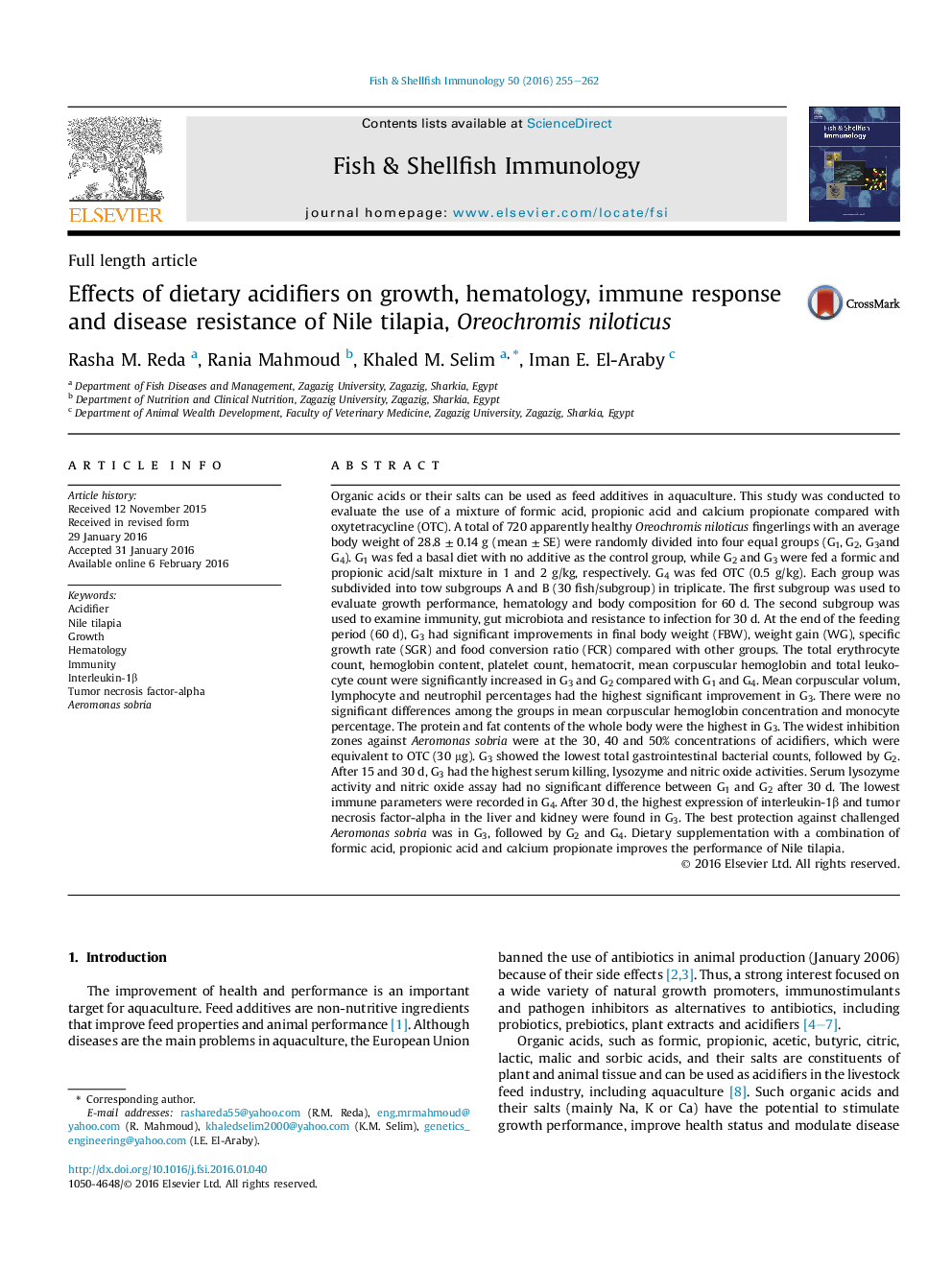| کد مقاله | کد نشریه | سال انتشار | مقاله انگلیسی | نسخه تمام متن |
|---|---|---|---|---|
| 2430692 | 1553624 | 2016 | 8 صفحه PDF | دانلود رایگان |

• Acidifiers improved growth performance, blood parameters and body composition of tilapia.
• Acidifier has in vitro and in vivo antibacterial activities.
• Acidifiers improved non specific immune parameters and immune genes of tilapia.
• Acidifiers enhanced disease resistance of tilapia.
Organic acids or their salts can be used as feed additives in aquaculture. This study was conducted to evaluate the use of a mixture of formic acid, propionic acid and calcium propionate compared with oxytetracycline (OTC). A total of 720 apparently healthy Oreochromis niloticus fingerlings with an average body weight of 28.8 ± 0.14 g (mean ± SE) were randomly divided into four equal groups (G1, G2, G3and G4). G1 was fed a basal diet with no additive as the control group, while G2 and G3 were fed a formic and propionic acid/salt mixture in 1 and 2 g/kg, respectively. G4 was fed OTC (0.5 g/kg). Each group was subdivided into tow subgroups A and B (30 fish/subgroup) in triplicate. The first subgroup was used to evaluate growth performance, hematology and body composition for 60 d. The second subgroup was used to examine immunity, gut microbiota and resistance to infection for 30 d. At the end of the feeding period (60 d), G3 had significant improvements in final body weight (FBW), weight gain (WG), specific growth rate (SGR) and food conversion ratio (FCR) compared with other groups. The total erythrocyte count, hemoglobin content, platelet count, hematocrit, mean corpuscular hemoglobin and total leukocyte count were significantly increased in G3 and G2 compared with G1 and G4. Mean corpuscular volum, lymphocyte and neutrophil percentages had the highest significant improvement in G3. There were no significant differences among the groups in mean corpuscular hemoglobin concentration and monocyte percentage. The protein and fat contents of the whole body were the highest in G3. The widest inhibition zones against Aeromonas sobria were at the 30, 40 and 50% concentrations of acidifiers, which were equivalent to OTC (30 μg). G3 showed the lowest total gastrointestinal bacterial counts, followed by G2. After 15 and 30 d, G3 had the highest serum killing, lysozyme and nitric oxide activities. Serum lysozyme activity and nitric oxide assay had no significant difference between G1 and G2 after 30 d. The lowest immune parameters were recorded in G4. After 30 d, the highest expression of interleukin-1β and tumor necrosis factor-alpha in the liver and kidney were found in G3. The best protection against challenged Aeromonas sobria was in G3, followed by G2 and G4. Dietary supplementation with a combination of formic acid, propionic acid and calcium propionate improves the performance of Nile tilapia.
Journal: Fish & Shellfish Immunology - Volume 50, March 2016, Pages 255–262